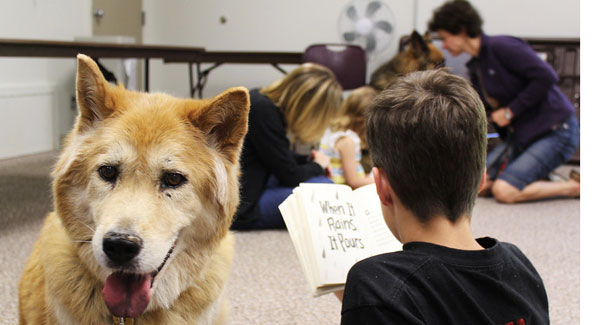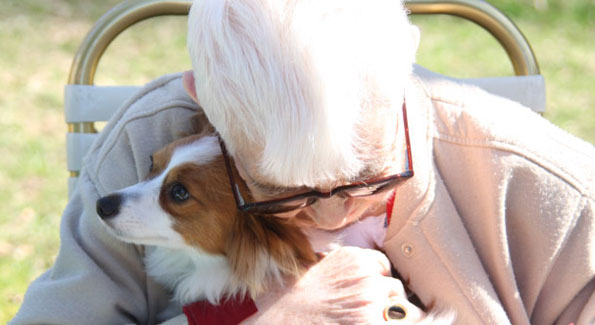This local nonprofit has the cutest mission ever – pairing dogs with kids who need practice reading
By Jane Hess Collins

Sometimes reading to a pet is easier than reading to an adult (photo courtesy of People Animals Love).
My granddaughter Annabelle reads fearlessly to her baby dolls and stuffed animals. Surrounded by her silent and adoring audience, her storybooks propped up in her hands (sometimes upside down) she reads to them with confidence and ease.
Uniquely brilliant as she is, at not-quite three years old Annabelle isn’t technically reading just yet. She doesn’t know that, though, and neither does her fan club.
Many kids read to their stuffed animals. The trouble, I think, begins when they actually learn to read when they start school. Their admiring toy audience is replaced by parents and other well-intended adults, who often focus on correcting every stumble and mispronounced word.
No wonder some kids are afraid to read.
The nonprofit People Animals Love (PAL) brilliantly addresses this by (cue up the “awwwww” meter) pairing doggies as listening buddies with kids who need reading practice at 35 sites throughout the metro DC area. This program sounded just too cute to be true, so I signed up as a PAL dog handler at the Arlington County Library on Monday night.
Normally the dog owner stays with the pet, but Laurel Edwards, PAL’s program and communications manager, arranged for Jetta, the six-year-old Chihuahua Dachshund mix owned by PAL’s executive director Rene Willis, to be my loaner dog for the evening.
Before the reading program began, seven dogs ranging from 15-pound Jetta to a 110-pound Bernese Mountain Dog and their owners mingled outside the library to socialize (“to get the butt-sniffing out of the way” as it was explained to me).
Next we moved into a room inside the library’s children section. The kids had signed up to read to the dogs in advance and, as always, the list was full with a few kids on stand-by.
Each dog was paired with one child, who read aloud for 15 minutes, and then another child took her place. My job, and the job of all of the dog owners, was to keep the dogs close by the child and otherwise be quiet.
Aside from “Hello, this is Jetta. Would you like to pet her?” I was to be nearly invisible, and could only help a child read if asked.

PAL needs more pet visit teams to visit the elderly at nursing homes and anywhere else where a pet brings comfort (photo courtesy of People Animals Love)
While ideally the reading pod includes just the child, the dog and the dog owner, sometimes the parents join in as well. In my PAL hour, Jetta and I were read to by four children from kindergarten to fifth grade. Two were accompanied by hovering helicopter moms.
Not surprisingly, those kids seemed more nervous than the two who read to us by themselves.
Actual reading improvement results are anecdotal at this point. However, children who struggle with dyslexia or learning English as a second language have thrived through participating in the PAL program, according to Julia Karell, the library’s youth services librarian.
Any doggie can be a PAL doggie as long as it passes a temperament test that evaluates how it behaves around people and other animals. PAL pet visit teams (dog and owner) have visited the Armed Forces Retirement Home for 25 years, as well as area libraries, nursing home, rehabilitation centers and schools.
As with most nonprofits, the demand is greater than the supply and PAL needs more volunteer pet visit teams. Click here to find out how to help.
What’s not to love about the healing power of pets?
Jane Hess Collins helps and encourages people to give back through her volunteering, writing, speaking, coaching and workshops. You can follow her other Get Out and Give Back volunteer stories on Facebook, Twitter and on her website.




